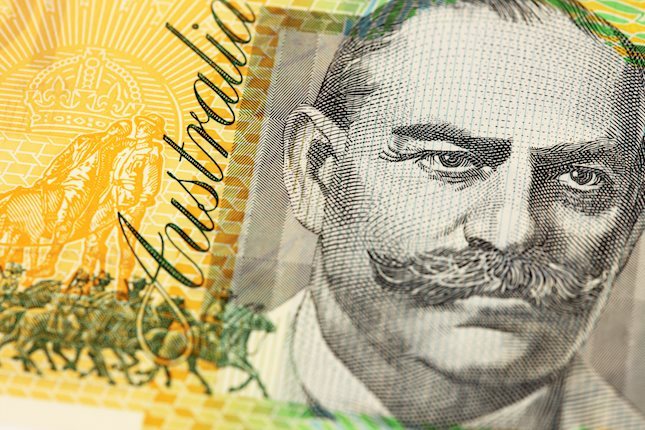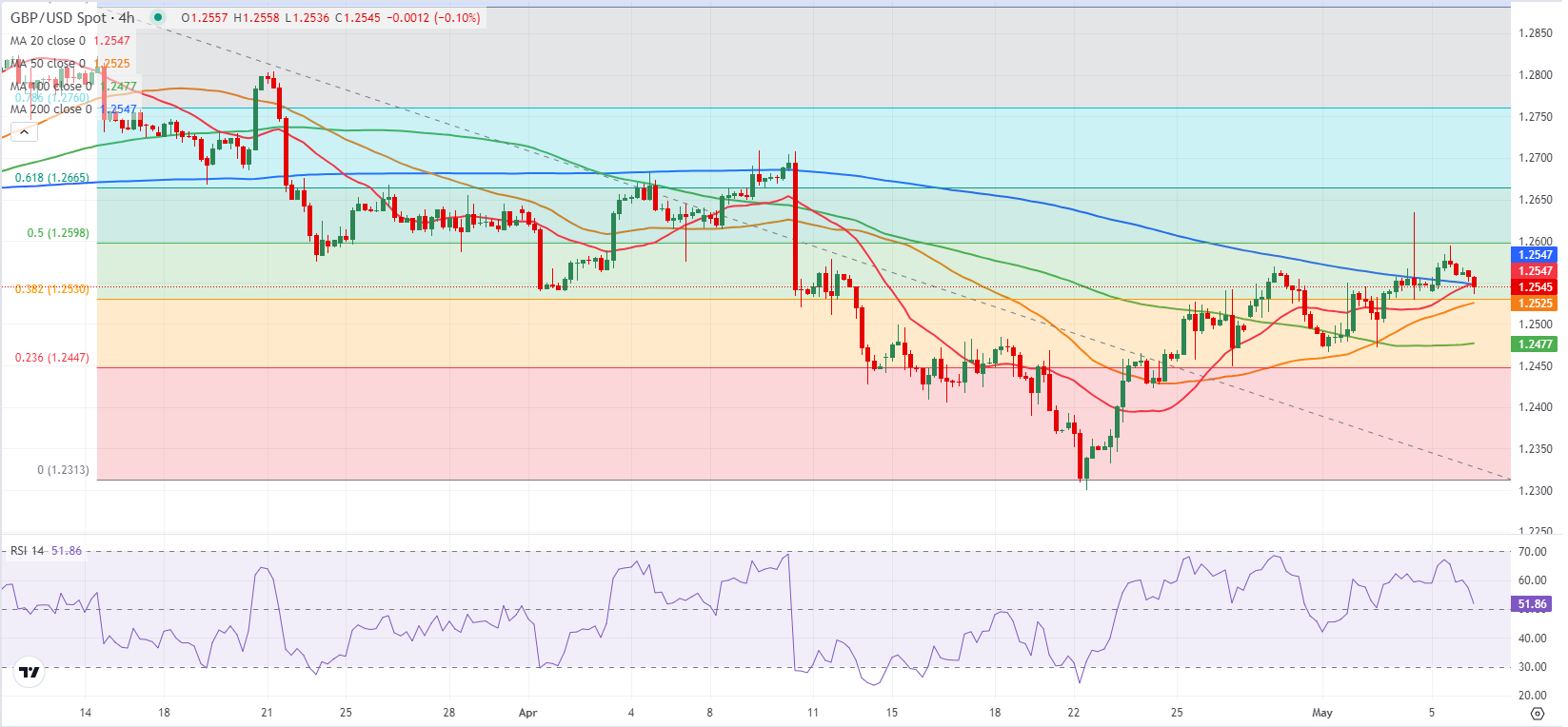- GBP/USD retreated below 1.2550 after closing in the green on Monday.
- The 200-day SMA aligns as key pivot level at 1.2550.
- The pair could stretch lower in case safe-haven flows return.
GBP/USD came within a touching distance of 1.2600 but erased a large portion of its daily gains in the late American session on Monday. The pair edges slightly lower in the early European session on Tuesday and was last seen trading a few pips below 1.2550.
British Pound PRICE This week
The table below shows the percentage change of British Pound (GBP) against listed major currencies this week. British Pound was the strongest against the US Dollar.
| USD | EUR | GBP | JPY | CAD | AUD | NZD | CHF | |
|---|---|---|---|---|---|---|---|---|
| USD | 0.02% | -0.08% | -0.77% | -0.09% | -0.20% | -0.09% | -0.17% | |
| EUR | -0.02% | -0.02% | -0.66% | -0.07% | -0.01% | -0.04% | -0.09% | |
| GBP | 0.08% | 0.02% | -0.68% | -0.04% | -0.01% | -0.03% | -0.07% | |
| JPY | 0.77% | 0.66% | 0.68% | 0.65% | 0.56% | 0.69% | 0.59% | |
| CAD | 0.09% | 0.07% | 0.04% | -0.65% | -0.21% | 0.02% | -0.01% | |
| AUD | 0.20% | 0.01% | 0.01% | -0.56% | 0.21% | -0.04% | -0.03% | |
| NZD | 0.09% | 0.04% | 0.03% | -0.69% | -0.02% | 0.04% | -0.03% | |
| CHF | 0.17% | 0.09% | 0.07% | -0.59% | 0.00% | 0.03% | 0.03% |
The heat map shows percentage changes of major currencies against each other. The base currency is picked from the left column, while the quote currency is picked from the top row. For example, if you pick the British Pound from the left column and move along the horizontal line to the US Dollar, the percentage change displayed in the box will represent GBP (base)/USD (quote).
Improving risk mood made it difficult for the US Dollar (USD) to find demand on Monday. During the American trading hours, however, comments from Federal Reserve officials helped Treasury bond yields rebound and allowed the USD to stay resilient against its rivals.
NY Fed President John Williams said that there will eventually be rate cuts but noted that it was worrisome when monthly inflation prints come in higher. Additionally, Richmond Fed President Thomas Barkin argued that the strong labor market will give the Fed more time to gain confidence that inflation will fall toward the 2% target.
In the absence of fundamental drivers and high-impact data releases, the risk perception could impact GBP/USD's action in the second half of the day.
At the time of press, US stock index futures were trading mixed. A bullish opening in Wall Street could limit the USD's gains and help GBP/USD hold its ground.
According to latest developments, Israel military has taken control of the Palestinian side of the Rafah crossing. Later in the day, ceasefire talks are expected to take place in Egypt. In case geopolitical tensions ease, risk flows could return to markets.
GBP/USD Technical Analysis
The Relative Strength Index (RSI) indicator on the 4-hour chart declined toward 50, highlighting a loss of bullish momentum.
The 200-day Simple Moving Average (SMA) aligns as key pivot level at 1.2550. If GBP/USD confirms that level as support, 1.2600 (Fibonacci 50% retracement of the latest downtrend) could be seen as next resistance before 1.2665 (Fibonacci 61.8% retracement).
In case GBP/USD stays below 1.2550, buyers could stay on the sidelines. In this scenario, supports could be seen at 1.2500 (psychological level, static level), 1.2475 (100-period SMA on the 4-hour chart) and 1.2445 (Fibonacci 23.6% retracement).
Pound Sterling FAQs
The Pound Sterling (GBP) is the oldest currency in the world (886 AD) and the official currency of the United Kingdom. It is the fourth most traded unit for foreign exchange (FX) in the world, accounting for 12% of all transactions, averaging $630 billion a day, according to 2022 data. Its key trading pairs are GBP/USD, aka ‘Cable’, which accounts for 11% of FX, GBP/JPY, or the ‘Dragon’ as it is known by traders (3%), and EUR/GBP (2%). The Pound Sterling is issued by the Bank of England (BoE).
The single most important factor influencing the value of the Pound Sterling is monetary policy decided by the Bank of England. The BoE bases its decisions on whether it has achieved its primary goal of “price stability” – a steady inflation rate of around 2%. Its primary tool for achieving this is the adjustment of interest rates. When inflation is too high, the BoE will try to rein it in by raising interest rates, making it more expensive for people and businesses to access credit. This is generally positive for GBP, as higher interest rates make the UK a more attractive place for global investors to park their money. When inflation falls too low it is a sign economic growth is slowing. In this scenario, the BoE will consider lowering interest rates to cheapen credit so businesses will borrow more to invest in growth-generating projects.
Data releases gauge the health of the economy and can impact the value of the Pound Sterling. Indicators such as GDP, Manufacturing and Services PMIs, and employment can all influence the direction of the GBP. A strong economy is good for Sterling. Not only does it attract more foreign investment but it may encourage the BoE to put up interest rates, which will directly strengthen GBP. Otherwise, if economic data is weak, the Pound Sterling is likely to fall.
Another significant data release for the Pound Sterling is the Trade Balance. This indicator measures the difference between what a country earns from its exports and what it spends on imports over a given period. If a country produces highly sought-after exports, its currency will benefit purely from the extra demand created from foreign buyers seeking to purchase these goods. Therefore, a positive net Trade Balance strengthens a currency and vice versa for a negative balance.
Information on these pages contains forward-looking statements that involve risks and uncertainties. Markets and instruments profiled on this page are for informational purposes only and should not in any way come across as a recommendation to buy or sell in these assets. You should do your own thorough research before making any investment decisions. FXStreet does not in any way guarantee that this information is free from mistakes, errors, or material misstatements. It also does not guarantee that this information is of a timely nature. Investing in Open Markets involves a great deal of risk, including the loss of all or a portion of your investment, as well as emotional distress. All risks, losses and costs associated with investing, including total loss of principal, are your responsibility. The views and opinions expressed in this article are those of the authors and do not necessarily reflect the official policy or position of FXStreet nor its advertisers. The author will not be held responsible for information that is found at the end of links posted on this page.
If not otherwise explicitly mentioned in the body of the article, at the time of writing, the author has no position in any stock mentioned in this article and no business relationship with any company mentioned. The author has not received compensation for writing this article, other than from FXStreet.
FXStreet and the author do not provide personalized recommendations. The author makes no representations as to the accuracy, completeness, or suitability of this information. FXStreet and the author will not be liable for any errors, omissions or any losses, injuries or damages arising from this information and its display or use. Errors and omissions excepted.
The author and FXStreet are not registered investment advisors and nothing in this article is intended to be investment advice.
Recommended Content
Editors’ Picks

AUD/USD extends the retreat to near 0.6650 as US Dollar finds footing
AUD/USD is back in the red, testing 0.6650 in Friday's Asian trading. A renewed US Dollar uptick undermines the pair, even as risk sentiment remains in a sweeter spot. However, the downside appears limited amid the RBA's hawkish stance and hopes for more Chinese stimulus could act as a tailwind for the Aussie.

USD/JPY drops back below 153.00 after Japan's verbal intervention
USD/JPY drops back below 153.00 early Friday, snapping the rebound. Japanese verbal intervention outweighs the upbeat market mood and the post-Fed US Dollar rebound, exerting a fresh bearish pressure on the pair. US sentiment data is next in focus.

Gold price slides back below $2,700 mark amid modest USD strength
Gold price met with a fresh supply and eroded a part of the overnight recovery gains. The Trump trade optimism revives the USD demand and weighs on the precious metal. Retreating US bond yields and bets for additional Fed rate cuts could help limit losses.

BTC touches new all-time high near $77,000 following Fed rate cut
Bitcoin price rallied and reached a new all-time high of $76,849 following the US Federal Reserve’s 25 basis point rate cut. Ethereum and Ripple followed suit and closed above their key resistance levels, hinting at a possible rally ahead.

Outlook for the markets under Trump 2.0
On November 5, the United States held presidential elections. Republican and former president Donald Trump won the elections surprisingly clearly. The Electoral College, which in fact elects the president, will meet on December 17, while the inauguration is scheduled for January 20, 2025.

Best Forex Brokers with Low Spreads
VERIFIED Low spreads are crucial for reducing trading costs. Explore top Forex brokers offering competitive spreads and high leverage. Compare options for EUR/USD, GBP/USD, USD/JPY, and Gold.
